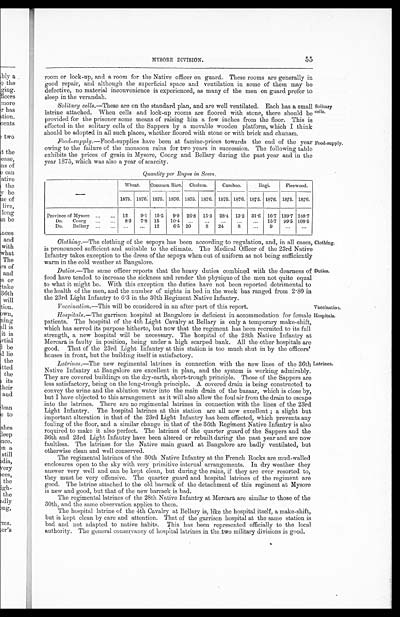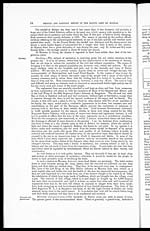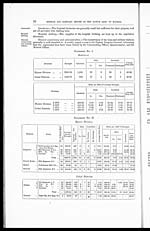Medicine - Institutions > Army health reports and medical documents > Medical and sanitary reports of the native army of Madras > Medical and sanitary report of the native army of Madras for the year 1876
(64) Page 55
Download files
Individual page:
Thumbnail gallery: Grid view | List view

MYSORE DIVISION.
55
room or lock-up, and a room for the Native officer on guard. These rooms are generally in
good repair, and although the superficial space and ventilation in some of them may be
defective, no material inconvenience is experienced, as many of the men on guard prefer to
sleep in the verandah.
Solitary cells. —These are on the standard plan, and are well ventilated. Each has a small
latrine attached. When cells and lock-up rooms are floored with stone, there should be
provided for the prisoner some means of raising him a few inches from the floor. This is
effected in the solitary cells of the Sappers by a movable wooden platform, which I think
should be adopted in all such places, whether floored with stone or with brick and chunam.
Solitary cells.
Food-supply. —Food-supplies have been at famine-prices towards the end of the year
owing to the failure of the monsoon rains for two years in succession. The following table
exhibits the prices of grain in Mysore, Coorg and Bellary during the past year and in the
year 1875, which was also a year of scarcity.
Food-supply.
Quantity per Rupee in Seers.
| Wheat. | Common Rice. | Cholum. | Cumboo. | Ragi. | Firewood. | |||||||
| 1875. | 1876. | 1875. | 1876. | 1875. | 1876. | 1875. | 1876. | 1875. | 1876. | 1875. | 1876. | |
| Province of Mysore | 12 | 9.1 | 15.5 | 9.9 | 26.8 | 15.3 | 28.4 | 13.2 | 31.6 | 16.7 | 139.7 | 148.7 |
| Do. Coorg | 8.3 | 7.8 | 15 | 10.4 | ... | ... | ... | ... | ... | 15.7 | 99.5 | 108.5 |
| Do. Bellary | ... | ... | 12 | 6.5 | 20 | 8 | 24 | 8 | ... | 9 | ... | ... |
Clothing. —The clothing of the sepoys has been according to regulation, and, in all cases,
is pronounced sufficient and suitable to the climate. The Medical Officer of the 23rd Native
Infantry takes exception to the dress of the sepoys when out of uniform as not being sufficiently
warm in the cold weather at Bangalore.
Clothing.
Duties. —The same officer reports that the heavy duties combined with the dearness of
food have tended to increase the sickness and render the physique of the men not quite equal
to what it might be. With this exception the duties have not been reported detrimental to
the health of the men, and the number of nights in bed in the week has ranged from 2.80 in
the 23rd Light Infantry to 6.3 in the 30th Regiment Native Infantry.
Duties.
Vaccination. —This will be considered in an after part of this report.
Vaccination.
Hospitals. —The garrison hospital at Bangalore is deficient in accommodation for female
patients. The hospital of the 4th Light Cavalry at Bellary is only a temporary make-shift,
which has served its purpose hitherto, but now that the regiment has been recruited to its full
strength, a new hospital will be necessary. The hospital of the 28th Native Infantry at
Mercara is faulty in position, being under a high scarped bank. All the other hospitals are
good. That of the 23rd Light Infantry at this station is too much shut in by the officers'
houses in front, but the building itself is satisfactory.
Hospitals.
Latrines. —The new regimental latrines in connection with the new lines of the 36th
Native Infantry at Bangalore are excellent in plan, and the system is working admirably.
They are covered buildings on the dry-earth, short-trough principle. Those of the Sappers are
less satisfactory, being on the long-trough principle. A covered drain is being constructed to
convey the urine and the ablution water into the main drain of the bazaar, which is close by,
but I have objected to this arrangement as it will also allow the foul air from the drain to escape
into the latrines. There are no regimental latrines in connection with the lines of the 23rd
Light Infantry. The hospital latrines at this station are all now excellent; a slight but
important alteration in that of the 23rd Light Infantry has been effected, which prevents any
fouling of the floor, and a similar change in that of the 36th Regiment Native Infantry is also
required to make it also perfect. The latrines of the quarter guard of the Sappers and the
36th and 23rd Light Infantry have been altered or rebuilt during the past year and are now
faultless. The latrines for the Native main guard at Bangalore are badly ventilated, but
otherwise clean and well conserved.
Latrines.
The regimental latrines of the 30th Native Infantry at the French Rocks are mud-walled
enclosures open to the sky with very primitive internal arrangements. In dry weather they
answer very well and can be kept clean, but during the rains, if they are ever resorted to,
they must be very offensive. The quarter guard and hospital latrines of the regiment are
good. The latrine attached to the old barrack of the detachment of this regiment at Mysore
is new and good, but that of the new barrack is bad.
The regimental latrines of the 28th Native Infantry at Mercara are similar to those of the
30th, and the same observation applies to them.
The hospital latrine of the 4th Cavalry at Bellary is, like the hospital itself, a make-shift,
but is kept clean by care and attention. That of the garrison hospital at the same station is
bad and not adapted to native habits. This has been represented officially to the local
authority. The general conservancy of hospital latrines in the two military divisions is good.
Set display mode to: Large image | Zoom image | Transcription
Images and transcriptions on this page, including medium image downloads, may be used under the Creative Commons Attribution 4.0 International Licence unless otherwise stated. ![]()
| Permanent URL | https://digital.nls.uk/74991496 |
|---|




